The Roman Legions in Britain
There are only a few legions that were ever stationed in Britain — some for much longer than others. In this area and its child pages, we will go over them. [The intent is to break this page down from one massive overall page, to smaller, bite-size pages detailing each Legion. Please bear with us during this process and... please also check back and see how we're doing.]
The Roman legion (Latin: legiō) was the largest military unit of the Roman army, composed of 5,600 infantry and 200 auxilia in the period of the Roman Empire (27 BC-AD 1453).
For most of the Roman Imperial period, the legions formed the Roman army's elite heavy infantry, recruited exclusively from Roman citizens, while the remainder of the army consisted of auxiliaries, who provided additional infantry and the vast majority of the Roman army's cavalry. (Provincials who aspired to citizenship gained it when honourably discharged from the auxiliaries.) The Roman army, for most of the Imperial period, consisted mostly of auxiliaries rather than legions.
Legions of Britain
- Legio II Adiutrix
- Legio II Augusta
- Legio VI Victrix
- Legio IX Hispana
- Legio XIV Gemina Martia Victrix
- Legio XX Valeria Victrix
Legio II Adiutrix
 Legio secunda adiutrix ("Rescuer Second Legion"), was a legion of the Imperial Roman army founded in AD 70 by the emperor Vespasian (ca. 69-79), originally composed of Roman navy marines of the classis Ravennatis. There are still records of II Adiutrix in the Rhine border in the beginning of the 4th century. The legion's symbols were a Capricorn and Pegasus.
Legio secunda adiutrix ("Rescuer Second Legion"), was a legion of the Imperial Roman army founded in AD 70 by the emperor Vespasian (ca. 69-79), originally composed of Roman navy marines of the classis Ravennatis. There are still records of II Adiutrix in the Rhine border in the beginning of the 4th century. The legion's symbols were a Capricorn and Pegasus.
The first assignment of II Adiutrix was in Germania Inferior, where the Batavian rebellion was at its peak. After the defeat of the rebels, II Adiutrix followed general Quintus Petillius Cerialis to Britain to deal with another rebellion led by Venutius. During the next years, the legion was to stay in the British Islands to subdue the rebel tribes of Scotland and Wales, with base camp probably at Chester.
Recalled
In 87, the legion was recalled to the continent to participate in the Dacian wars of emperor Domitian. Between 94 and 95, still in Dacia, later emperor Hadrian served as military tribune in the II Adiutrix.
In the summer of 106 the legion took part to the siege of the Dacian Capital Sarmisegetusa. After Trajan's Dacian Wars of 101-106, the legion was located in Aquincum (modern Budapest), which would be its base camp for the years to come.
Legio II Augusta
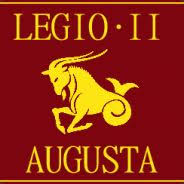 Legio II Augusta in Britain
Legio II Augusta in Britain
Legio secunda Augusta ("Augustus' Second Legion") was a legion of the Imperial Roman army that was founded during the late Roman republic.
Legio II Augusta participated in the Roman conquest of Britain in 43AD. Future emperor Vespasian was the legion's commander at the time, and led the campaign against the Durotriges and Dumnonii tribes. Although it was recorded as suffering a defeat at the hands of the Silures in 52, Legio II proved to be one of the best legions, even after its disgrace during the uprising of queen Boudica, when its praefectus castrorum, who was then its acting commander (its legatus and tribunes probably being absent with the governor Suetonius Paulinus), contravened Suetonius' orders to join him and so later committed suicide.
After the Revolt
After the defeat of Boudica, Legio II was dispersed over several bases; from 66 to around 74 it was stationed at Glevum (modern Gloucester), and then moved to Isca Augusta (modern Caerleon), building a stone fortress that the soldiers occupied until the end of the 3rd century. Legio II Augusta also had connections with the camp at Alchester in Oxfordshire; stamped tiles record it in the 2nd century at Abonae (Sea Mills, Bristol) on the tidal shore of the Avon.
2nd and 3rd centuries
In 122, Legio II Augusta helped to build Hadrian's Wall.
In 142, Legio II Augusta helped to build the Antonine Wall and are recorded on The Bridgeness Slab.
In 196, Legio II Augusta supported the claim for the purple of the governor of Britannia, Clodius Albinus, who was defeated by Septimius Severus. On the occasion of Severus' Scottish campaign, the Second moved to Carpow, to return to Caerleon under Alexander Severus.
Legio VI Victrix
 Legio VI Victrix
Legio VI Victrix
Legio sexta victrix ("Victorious Sixth Legion") was a legion of the Imperial Roman army founded in 41 BC by the general Octavian (later known as the Emperor Augustus).
Legio VI Victrix in Britain
In 119, Hadrian relocated Legio VI to northern Britannia, to assist those legions already present in quelling the resistance there. Victrix was key in securing victory, and would eventually replace the diminished Legio IX Hispana at Eboracum. In 122 the legion started work on Hadrian's Wall which would sustain the peace for two decades.
Twenty years later, Legio VI helped construct the Antonine Wall, but that was then was largely abandoned by 164.
In 175, the Roman emperor, Marcus Aurelius, defeated the Iazyges tribe of Sarmatians. He took them into Roman service and settled 5,500 of them in Britain; some were assigned to the Legio VI Victrix based in York and others are attested in a unit at Ribchester, south of Lancaster.
Mutiny
In 185, the British legions mutinied and put forward a commander of their own, named Priscus, to replace the unpopular Emperor Commodus, but the former declined. The mutiny was suppressed by Pertinax, who would later become emperor himself after Commodus was murdered.
The Legate of the legion in the late second century, Claudius Hieronymianus, dedicated a temple to Serapis in Eboracum in advance of the arrival of Septimius Severus in AD208.
An altar to Hercules was dedicated by Gaius Vitellius Atticianus, Centurion of the Legio VI Victrix, at Whitley Castle (Epiacum).
Commanders
- Quintus Antonius Isauricus - AD 130s
- Claudius Hieronymianus - AD 190-AD 212
Legio IX Hispana
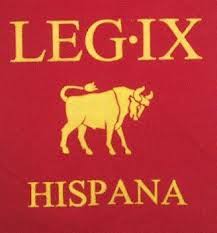 Legio IX Hispana ("Spanish 9th Legion"), also Legio nona Hispana ("Spanish Ninth Legion"), was a legion of the Imperial Roman army that existed from the 1st century BC until at least AD 120. The legion fought in various provinces of the late Roman Republic and early Roman Empire. It was stationed in Britain following the Roman invasion in 43 AD. Leg. IX disappears from surviving Roman records after c. AD 120 and there is no extant account of what happened to it.
Legio IX Hispana ("Spanish 9th Legion"), also Legio nona Hispana ("Spanish Ninth Legion"), was a legion of the Imperial Roman army that existed from the 1st century BC until at least AD 120. The legion fought in various provinces of the late Roman Republic and early Roman Empire. It was stationed in Britain following the Roman invasion in 43 AD. Leg. IX disappears from surviving Roman records after c. AD 120 and there is no extant account of what happened to it.
The unknown fate of the legion has been the subject of considerable research and speculation. One theory (per historian Theodor Mommsen) was that the legion was wiped out in action in northern Britain soon after 108, the date of the latest datable inscription of the Ninth found in Britain, perhaps during a rising of northern tribes against Roman rule. This view was popularised by the 1954 novel The Eagle of the Ninth in which the legion is said to have marched into Caledonia (modern day Scotland), after which it was "never heard of again."
This theory of Legio IX being "wiped out" fell out of favor among scholars as successive inscriptions of IX Hispana were found in the site of the legionary base at Nijmegen (Netherlands), suggesting the Ninth may have been based there from c. 120, later than the legion's supposed annihilation in Britain. The Nijmegen evidence has led to suggestions that IX Hispana was destroyed in later conflicts of the 2nd century. Suggestions include the Bar Kokhba revolt (132-135) or Marcus Aurelius' war against Parthia (161-166) in Armenia.
Britain (AD 43-108 — at least)
In AD 43 Leg. IX most likely participated in the Roman invasion of Britain led by emperor Claudius and general Aulus Plautius, because they soon appear amongst the provincial garrison. In AD 50, the Ninth was one of two legions that defeated the forces of Caratacus at Caer Caradoc. Around the same year, Leg. IX constructed a fort, Lindum Colonia, at Lincoln. Under the command of Caesius Nasica they put down the first revolt of Venutius between 52 and 57.
Leg. IX suffered a serious defeat at the Battle of Camulodunum under Quintus Petillius Cerialis in the rebellion of Boudica (61), when most of the foot-soldiers were killed in a disastrous attempt to relieve the besieged city of Camulodunum (Colchester). Only the cavalry escaped. The legion was later reinforced with legionaries from the Germania provinces. When Cerialis returned as governor of Britain ten years later, he took command of Leg. IX once more in a successful campaign against the Brigantes in 71-2, to subdue north-central Britain. Around this time they constructed a new fortress at Eboracum (York), as shown by finds of tile-stamps from the site.
The Ninth participated in Agricola's invasion of Caledonia (modern Scotland) in 82-3. According to Tacitus the legion narrowly escaped destruction when the Caledonians beyond the Forth launched a surprise attack at night on their fort. The Caledonians "burst upon them as they were terrified in their sleep." In desperate hand-to-hand fighting the Caledonians entered the camp, but Agricola was able to send cavalry to relieve the legion. Seeing the relief force, "the men of Leg. IX recovered their spirit, and sure of their safety, fought for glory," pushing back the Caledonians. The legion also participated in the decisive Battle of Mons Graupius.
The last attested activity of Leg. IX in Britain is during the rebuilding in stone of the legionary fortress at Eboracum (York) in 108. This is recorded in an inscribed stone tablet discovered in 1864.
Germania Interior (108AD-130AD)
Several inscriptions attesting Leg. IX Hispana have been found in the site of the legionary fortress on the lower Rhine river at Noviomagus Batavorum (Nijmegen, Netherlands). These include some tile-stamps (dated 104-120); and a silver-plated bronze pendant, found in the 1990s, that was part of a phalera (military medal), with "LEG HISP IX" inscribed on the reverse. In addition, an altar to Apollo, dating from this period, was found at nearby Aquae Granni (Aachen, Germany), erected in fulfillment of a vow, by Lucius Latinius Macer, who describes himself as primus pilus (chief centurion) and as praefectus castrorum ("prefect of the camp", i.e. third-in-command) of Leg. IX Hispana. (it was commonplace for chief centurions, on completion of their single-year term of office, to be promoted to praefectus castrorum).
The archaeological evidence thus appears to indicate that elements of Leg. IX Hispana were present at Noviomagus sometime after 104 (when the previous incumbent legion, Leg. X Gemina, was transferred to the Danube) and that Leg. IX was probably replaced by a detachment of Legio XXX Ulpia Victrix not long after AD 120. Less clear is whether the whole IX legion was at Nijmegen or simply a detachment. The evidence for the presence of senior officers such as Macer convinced several scholars that the Ninth Legion as a whole was based there between 121 and 130. It may have been both, first a detachment, later followed by the rest of the legion: a vexillatio Britannica ("British detachment") is also attested at Nijmegen in this period. However, it is unclear whether this detachment was drawn from the Leg. IX Hispana (and its attached auxiliary regiments) alone, or from a mix of various British-based units.
Legio XIV Gemina Martia Victrix
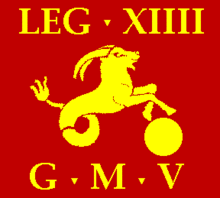 Stationed in Moguntiacum, Germania Superior since AD 9, Legio XIV Gemina Martia Victrix was one of four legions used by Aulus Plautius and Claudius in the Roman invasion of Britain in AD 43. It built its legionary fortress at Mancetter on Watling Street and by AD 58 it had moved its base to Wroxeter.
Stationed in Moguntiacum, Germania Superior since AD 9, Legio XIV Gemina Martia Victrix was one of four legions used by Aulus Plautius and Claudius in the Roman invasion of Britain in AD 43. It built its legionary fortress at Mancetter on Watling Street and by AD 58 it had moved its base to Wroxeter.
In Latin: Legio quarta decima Gemina ("The Twinned Fourteenth Legion") was a legion of the Imperial Roman army, levied by Julius Caesar in 57 BC. The cognomen Gemina (Twinned) was added when the legion was combined with another understrength legion after the Battle of Actium. The cognomen Martia Victrix (martial & victorious) was added sequentially following their service in the Pannonian War c. AD 9 and the defeat of Boudicca in AD 61. The emblem of the legion was the Capricorn, as with many of the legions levied by Caesar, their shield device displayed the thunderbolt of Jupiter with wings. It was the only legion to do so in the same manner as the Praetorian Guard.
Legio XIV during the Boudiccan Revolt
It took part in the defeat of Boudicca in 60 or 61. At the Battle of Watling Street the 14th defeated Boudicca's force of 230,000, according to Tacitus and Dio, with their meager force of 10,000 Legionaries and Auxiliaries. This act secured them as Nero's "most effective" legion, and he kept them garrisoned in Britain during the next few years to keep the uneasy tribes in check.
Transferred
In 67 AD the legion was sent to the Balkans in preparation for a campaign against the Parthians that Nero planned but which never materialised.
Legio XX Valeria Victrix
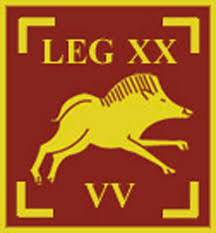 Legio XX Valeria Victrix, in English Twentieth Victorious Valeria Legion was a legion of the Imperial Roman army.
Legio XX Valeria Victrix, in English Twentieth Victorious Valeria Legion was a legion of the Imperial Roman army.
The origin of the Legion's name is unclear and there are various theories, but the legion may have gained its title Valeria Victrix from a victory it achieved during the Great Illyrian revolt under the command of the general Marcus Valerius Messalla Messallinus.
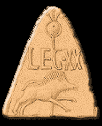 Legio XX had a boar as its emblem >>>>
Legio XX had a boar as its emblem >>>>
Stationed in Britain
The legion was moved from its fortress at Novaesium (Neuss) in Germany to take part in the Claudian invasion of Britain in ad43, when a new legionary fortress was established in the centre of the British capital at Camulodunum (Colchester, Essex). From this time forward, the Twentieth Legion would be permanently stationed in Britain.
The legion was again moved, by the proconsul Ostorius Scapula to a new vexillation-sized fortress at Kingsholm in Gloucester ad49, and a colony of veterans left behind at Colchester. The majority of the colony's citizens would probably have come from the Twentieth Legion, though almost certainly, they would have been joined by a few soldiers from the other British legions who were then due for retirement.
Victorious Against Boudicca
The Boudican rebellion of ad60/61 started with the torching of the new Roman colony at Claudia Camulodunensis, and the sacking of two other Roman towns; Londinium (London) and Verulamium (Saint Alban's). This was accompanied by the complete destruction of a vexillation of Legio IX Hispana, as the Iceni and Trinovantes ran amok throughout south-east Britain. The Roman proconsul Suetonius Paullinus, then on campaign against the Ordovices tribe on Mona Insula (Isle of Anglesey), was forced to march his army back to the Midlands, where he confronted the British forces near Manduessedum (Mancetter, Warwickshire).
As far as can be ascertained, his forces consisted of a vexilatio of Legio XX, the whole of Legio XIV Gemina, together with several other Auxiliary forces. Though vastly outnumbered, the Roman general was able to secure a victory due to the presence of his highly-trained legionary troops, and the Romans reputedly slew eighty thousand British warriors. Both Legios XX and XIV were to obtain titles for their decisive part in this campaign (vide infra).
Shortly after the Boudican revolt c.AD65, Legio XX was moved from the Kingsholm fortress in Gloucester, to Viroconium (Wroxeter, Shropshire) where they took over the fortress of Legio XIV Gemina who had been removed to Germany ca. ad64. They were in turn replaced at Gloucester by Legio II Augusta, who were to build a new legionary fortress on a nearby site and were moved up piecemeal from Isca Dumnonorum (Exeter, Devon) c.ad67.
Favoured by Agricola
The legion, under the command of the legionary legate Gnaeus Julius Agricola, was marched along the western coast of Britain and across the Pennines. Acting in unison with the main force comprising of Legio IX Hispana and Auxiliaries under the command of the proconsular governor Quintus Petillius Cerialis which moved from Malton along the Vale of York. Legio XX Valeria was instrumental in the operation to catch the Brigantian forces of Venutius in a pincer movement at Stanwick in North Yorkshire.
Agricola used his old legion when he returned to Britain as proconsular governor in a sweeping series of campaigns in the highlands of Caledonia between ad78 and ad84 during which the legion was first moved to a campaign fortress at Carlisle before establishing a new legionary fortress at Inchtuthil in Perthshire.
The Inchtuthil fortress was still incomplete when the order for it to be demolished was issued circa AD88 and the legion removed to Deva (Chester, Cheshire), where they replaced Legio II Adiutrix which Domitian had withdrawn from Britain for use in the Dacian Wars.
Vexillations of Legio XX, together with others from Legio VI Victrix were used, along with the whole of Legio II Augusta to build the Antonine wall in lowland Scotland.




















